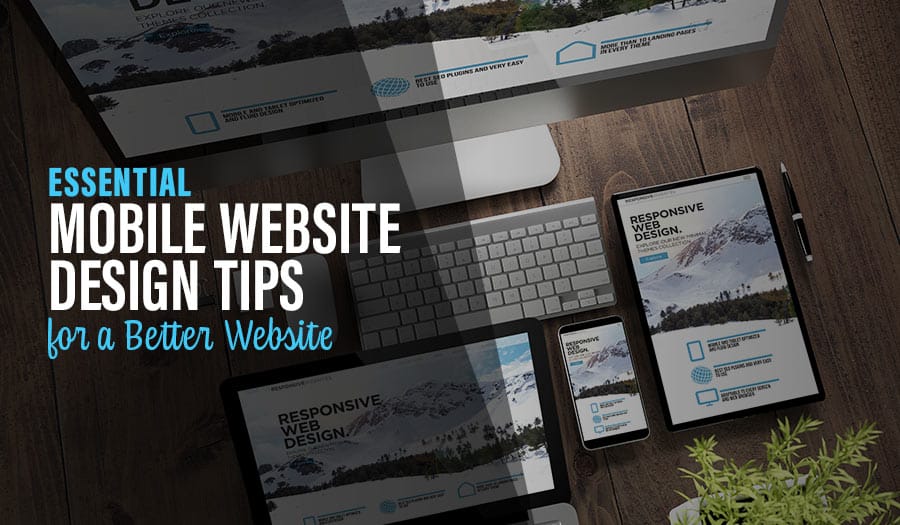In today’s dynamic digital world, having an optimized mobile website is no longer a luxury but a necessity. With mobile devices accounting for over 54% of global website traffic, businesses must prioritize mobile website design to stay ahead of the curve. Let’s explore Essential Mobile Website Design Tips for a Better Website.
This blog post dives deep into the essentials of mobile website design, exploring various techniques, practices, and tools to create a seamless and effective mobile experience for your users. Get ready to embark on the journey towards a mobile-friendly website that caters to your audience and converts them into loyal customers.
Mobile Web Design: A Short Summary
- Mobile website design is essential to capture global internet traffic, cater to mobile users and improve user experience.
- Professional mobile web design should focus on simplified navigation, readability & optimized media for increased engagement & conversions.
- Leverage tools & resources such as frameworks, testing/analytics tools and expert advice from Pixel Fish for effective mobile website design.
Essential Mobile Website Design Tips for a Better Website
- Understanding Mobile-Friendly Websites
- The Significance of Mobile Website Design
- Key Elements of Effective Mobile Website Design
- Top Mobile Website Design Practices to Implement
- Tools and Resources for Mobile Website Design
Understanding Mobile-Friendly Websites
A mobile-friendly website is optimized for all devices and provides the best user experience on mobile screens. Mobile web design differs from desktop design, as mobile screens are smaller, page elements are stacked in a single column, and text and buttons are proportionally larger for easy reading and interaction. A mobile-friendly website opens up new business opportunities, expanding their customer base and leading to increased lead generation and sales.
This concept of mobile-friendliness can be broken down into three main aspects: mobile devices and user behavior, responsive web design vs a separate mobile site, and the benefits of mobile responsive design vs a separate mobile site.
Let’s dive into each of these aspects in the following subsections.
Mobile Devices and User Behavior
Mobile devices have revolutionized the way we interact and conduct business, making it essential for websites to cater to the unique needs of mobile users. One key aspect in mobile website design is the implementation of search features that enable users to quickly locate what they are looking for. Facilitating contact from potential customers on a mobile website is also crucial, as 84% of consumers consider customer service a critical factor when purchasing.
Responsive web design comes in handy to tackle these challenges, ensuring that a website appears aesthetically pleasing on all devices, including desktops and mobile devices, while also facilitating user navigation and enhancing loading speed and performance across multiple devices. Thus, it is imperative to understand the relationship between mobile devices, user behavior, and the need for mobile-friendly websites.
Responsive Web Design vs a Separate Mobile Site
Responsive web design and separate mobile sites are two approaches to creating mobile-friendly websites. A separate mobile site has its own distinct URL for mobile devices, while responsive design adjusts to the device’s screen size. Responsive web design enables websites to be optimally displayed on both a desktop computer and mobile devices, while a separate mobile site can provide a tailored experience for mobile users, with improved load times and a simpler user experience.
For those just starting out, utilizing website templates that include an adaptation for mobile usage is the most suitable choice. The site will be reformatted to give a mobile-friendly view. Font sizes, images, etc. will be optimized for the best user experience. For example, the Leadpages template in the hero section is an excellent choice for mobile optimization, as the menu is automatically moved to the hamburger icon for a streamlined experience.
Benefits of Mobile Responsive Design vs a Separate Mobile Site
When comparing mobile responsive design and separate mobile sites, it’s important to weigh the benefits of each approach. Mobile responsive design offers several advantages, such as enhanced usability, superior customer experience, faster page speed, reduced bounce rate, and the potential to reach a broader audience. Additionally, it can help optimize websites for mobile search, improving performance and design by adapting content to users. Furthermore, it can reduce development time and cost by eliminating the requirement for a separate mobile website.
On the other hand, maintaining a separate mobile site can be challenging, as it necessitates distinct content and design for each device, including desktop computers. Keeping up with the ever-evolving mobile landscape can be difficult due to the frequent release of new devices and operating systems, making it essential to optimize your desktop site as well.
Based on these factors, it’s clear that mobile responsive design is the most advantageous choice for constructing a mobile-friendly website, as it offers various advantages and eliminates the necessity for a distinct mobile site.
The Significance of Mobile Website Design
As mobile devices transform the way we interact and conduct business, the importance of mobile website design cannot be overlooked. Most people are now accessing the web from their mobile devices. This shift has driven a huge amount of web traffic. Having a mobile-friendly website can significantly improve user experience, engagement, and conversion rates. As Thomas Husson aptly noted, mobile is becoming an essential digital hub and a gateway to the physical world. Crafting a great mobile web design experience is of utmost importance, as 57% of global internet traffic originates from mobile devices.
To further emphasize the significance of mobile website design, let’s explore how to cater to mobile users, understand Google’s mobile-first indexing, and discuss the impacts of a poorly optimized mobile website in the following subsections.
Catering to Mobile Users via a mobile friendly website
The growing need to cater to mobile users and their browsing habits has led to the development of various strategies for creating mobile responsive website layouts and optimizing website speed. Some of these strategies include utilizing flexible grids and layouts, using media queries to adjust the layout for various screen sizes, and employing relative units for font sizes.
Additionally, website speed can be optimised by compressing images, utilizing caching, minifying HTML, CSS, and JavaScript, and employing a content delivery network.
It’s also essential to provide a seamless browsing experience on mobile devices by employing mobile-friendly design elements such as search features, facilitating contact from customers, and using HTML5 in place of Adobe Flash for audio and video playback, animation, and interactive content. By implementing these strategies, businesses can effectively cater to the needs of mobile users and enhance their overall browsing experience.
Google’s Mobile-First Indexing
Google’s mobile-first index is a system that determines a website’s search result ranking primarily based on the content of its mobile version vs the desktop version of website. This makes it crucial for businesses to optimize their website’s mobile version in order to rank higher in search results. Google’s mobile-first indexing best practices may provide useful guidance for optimizing a website’s mobile version.
A mobile-friendly website can provide an advantage in terms of ranking and visibility, as it may be given preference in mobile search engine results, resulting in increased traffic and conversions. Thus, understanding Google’s mobile-first indexing and its impact on website ranking is essential for businesses to succeed in the digital landscape.
Impacts for Poorly Optimised Mobile Websites
A poorly optimized mobile website can result in a suboptimal user experience, slow loading times, decreased engagement, and a diminished search engine ranking. Additionally, it can lead to a higher bounce rate and lower conversions, thus detrimental to revenue.
Ensuring visitors can easily contact you on a mobile website is also crucial, as prompt responses to inquiries can lead to increased customer satisfaction and loyalty.
Optimising your mobile website by incorporating best practices such as responsive design, simplified navigation, optimized loading times, larger text and buttons, and a search feature is essential to avoid these negative impacts. Businesses can ensure a seamless user experience, leading to increased engagement, conversions, and revenue.
Key Elements of Effective Mobile Website Design
To create an effective mobile website, it’s essential to focus on key elements such as simplified navigation, readability, and optimized media. By incorporating these elements, businesses can provide a seamless and enjoyable browsing experience for their mobile users, ultimately leading to increased engagement and conversions.
In the following subsections, let’s further explore these key elements and their importance in creating an effective mobile website.
Simplified Navigation
Simplified navigation is critical for a smooth mobile user experience, as it enables users to swiftly and effortlessly locate the information they require without having to traverse through a cumbersome dropdown menu. Dropdown menus can be particularly challenging on mobile devices due to the limited screen size and potential sluggishness and awkwardness when navigating smaller screens.
A simpler menu with fewer options and direct links to pages containing various categories is recommended for dropdown menus on mobile websites. For example, the customized mobile menu on S&W Beauty’s website is highlighted by a bejeweled version of the hamburger icon, which assists in directing user attention to the menu and facilitating its accessibility. Similarly, the hamburger menu for Jonathan Van Ness has been strategically placed on the right-hand side of mobile screen, allowing visitors to quickly identify where to access additional information.
Readability and Typography
Ensuring readability and appropriate typography for mobile devices is crucial, as users should not be required to zoom in, pop up, or scroll horizontally to read content. By increasing the size of text on a mobile site, businesses can guarantee that all text can be read instantly without requiring any modifications.
The overall experience of Jonathan Van Ness’s mobile website is a great example of how readability and typography come into play. The mobile homepage is concise and utilizes a carousel banner to emphasize the essential information on the site. Focusing on legibility and typography ensures that your website content is easily accessible and engaging for mobile users.
Optimized Media and Loading Speed
Optimized media and loading speed are essential components of mobile website design, as they can significantly improve page load times, reduce bounce rates, increase website traffic, generate more potential leads, and enhance user experience. To optimize media and loading speed, businesses can employ various strategies such as compressing images, utilizing caching, minifying code, and employing a content delivery network.
By optimizing media and loading speed, businesses can provide an improved user experience, leading to increased engagement, conversions, and revenue. Investing time and effort into optimizing media and loading speed is crucial to creating an effective mobile website.
Top Mobile Website Design Practices to Implement
Implementing top mobile website design practices can help businesses create seamless and effective mobile experiences for their users. By focusing on aspects such as prioritizing content, enhancing user interactions, and streamlining forms and CTAs, businesses can ensure that their mobile website caters to their audience and converts them into loyal customers.
In the following subsections, let’s dive deeper into these top mobile website design practices and their implementation.
Prioritize Content and Functionality
Focusing on essential content and functionality is crucial for a better mobile experience. Some recommended approaches for prioritizing content and functionality in mobile website design include keeping the design simple, prioritizing page content, optimizing for touch, using responsive design, and ensuring accessibility and inclusivity.
Jonathan Van Ness’s mobile website is an example of a mobile website that utilizes prioritization of content and functionality. The mobile homepage is concise and utilizes a carousel banner to emphasize the essential information on the site. Businesses can create a mobile website that effectively caters to their users’ needs by prioritising content and functionality.
Enhance User Interactions
Improving user interactions on their mobile apps and websites can be achieved by keeping the design straightforward, making the app instinctive and consistent, providing pertinent mobile-only functionalities, utilizing various forms of feedback, and adhering to design patterns to reduce the learning curve for users. Examples of mobile-only functionalities include user registration, user-generated content, date and location management, messaging, push notifications, high-quality image resolution, search feature, and social media integration.
By enhancing user interactions through mobile-friendly design elements and functionalities, businesses can provide their mobile users a seamless and enjoyable browsing experience, ultimately leading to increased engagement and conversions.
Streamline Forms and CTAs
Simplifying forms and CTAs can significantly increase conversions on mobile devices. Ensuring visibility of CTAs can be achieved by positioning them above the fold, where users can view them without scrolling. Additionally, optimizing forms for mobile devices is crucial to enhance user experience and facilitate completion of forms by mobile users.
By streamlining forms and CTAs, businesses can create a mobile website that encourages users to take action, ultimately leading to increased engagement, conversions more leads, and revenue.
Tools and Resources for Mobile Website Design
In order to create a successful mobile website, businesses can leverage various tools and resources for mobile website design, such as design tools and frameworks, and testing and analytics tools. Utilizing these tools and resources can help businesses create an optimized and effective mobile website that caters to their users’ needs.
Let’s explore some of the popular tools and resources for mobile website design in the following subsections.
Design Tools and Frameworks
Design tools and frameworks are software programs and libraries that enable web designers to create mobile-friendly websites. Some popular design tools for mobile website design include Wix, Squarespace, Shopify, WordPress, Adobe Dreamweaver, and Figma. Popular frameworks for mobile website design include React, Angular, Meteor, Node.js, and jQuery.
By utilizing these design tools and frameworks, businesses can create mobile websites and desktop websites that are visually appealing, engaging, and optimized for all devices, providing a seamless user experience for their customers.
Testing and Analytics
Employing testing and analytics tools can help businesses optimize their mobile website performance and enhance user experience. Some popular testing and analytics tools include Google Analytics, Amplitude, Mixpanel, and UXCam. These tools can help businesses understand how users interact with their websites and what modifications should be implemented to improve the user experience.
By leveraging testing and analytics tools, businesses can gain valuable insights into their mobile website performance and make data-driven decisions to optimize their website for better user engagement and conversions.
Pixel Fish are experts at Mobile Website Design
Pixel Fish is a leader in mobile website design, with extensive experience and expertise in creating visually appealing and engaging websites designed specifically optimized for mobile devices. Their team of experienced designers and developers is well-versed in the latest technologies and trends in mobile website design, ensuring that your business receives a mobile website that is optimized for all devices, easy to navigate, and offers an exceptional user experience.
Pixel Fish provides a variety of services for mobile website design, such as responsive design, mobile-friendly navigation, optimized media, and streamlined forms and CTAs. By partnering with Pixel Fish, you can ensure that your business gets the best possible mobile website that caters to your audience and converts them into loyal customers.
In conclusion, mobile website design is an essential aspect of the digital landscape, with mobile devices accounting for a significant portion of global internet traffic. By understanding the importance of mobile-friendly websites, implementing best practices, and leveraging available tools and resources, businesses can create a seamless and enjoyable mobile experience for their users.
As a leader in mobile website design, Pixel Fish provides expert services to help businesses create mobile websites that cater to their audience and convert them into loyal customers. So, it’s time to take the plunge and optimize your mobile website for success!
Frequently Asked Questions
What website design is mobile-friendly?
A mobile-friendly website design is one that has been created with the user in mind, taking into account all the various sizes and shapes of phones and tablets. The design should incorporate features such as a responsive layout, mobile menus, and clearly visible elements for optimal viewing on any device.
By implementing these measures, websites can provide an enjoyable experience to their users regardless of how they choose to view it.
What is mobile design in web design?
Mobile design in web design is a proactive approach that prioritizes designing for mobile devices first. It involves creating and optimizing websites for hand-held devices such as smartphones and tablets and implementing responsive design to ensure the site adapts to the small screen size it’s viewed on.
Responsive design is a technique that allows a website to be viewed on any device, regardless of the size of the screen. It uses a combination of flexible grids and images.
Which type of design will you use to make a desktop website mobile-friendly?
For a website to be mobile-friendly, you should use responsive web design. This allows the website to adapt to the device used, ensuring that content is optimized regardless of screen size or platform.
Additionally, responsive design aids with SEO, helping improve the visibility of your website on search engines.
What are the key elements of effective mobile website design?
For effective mobile website design, simplifying navigation, optimizing readability, and ensuring swift loading speed is essential.
Take your business to the next level with a Pixel Fish Website.
Check out some of our latest Website Design projects.
View some case studies of our website design work:
Thriviae
Othman Lawyers
Arena Mars
Joe Pien Chartered Accountants
Further Information
Why you should use Elementor for your new WordPress Website
An Introduction to Website Design for Small Business
How Professional Custom Web Design can help your business stand out online
Understanding WooCommerce Website Development for Ecommerce Success
Get the Best Custom Website Design Solution for Your Business
Exploring the Benefits of the Divi Theme for WordPress
Comprehensive Guide to Ecommerce Web Design



